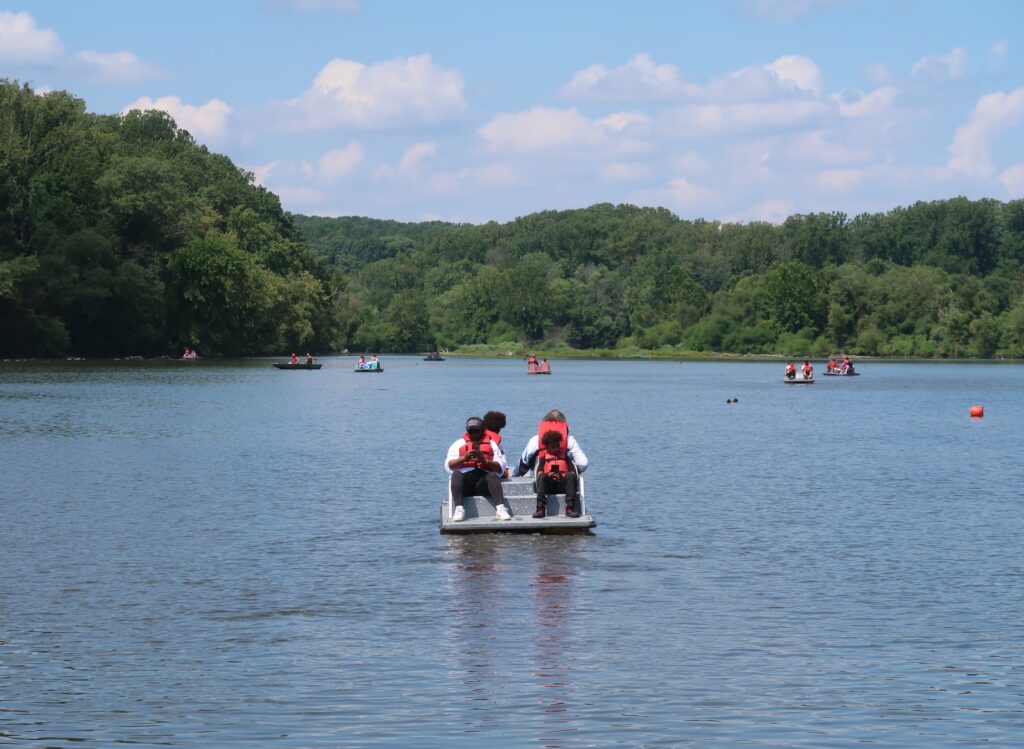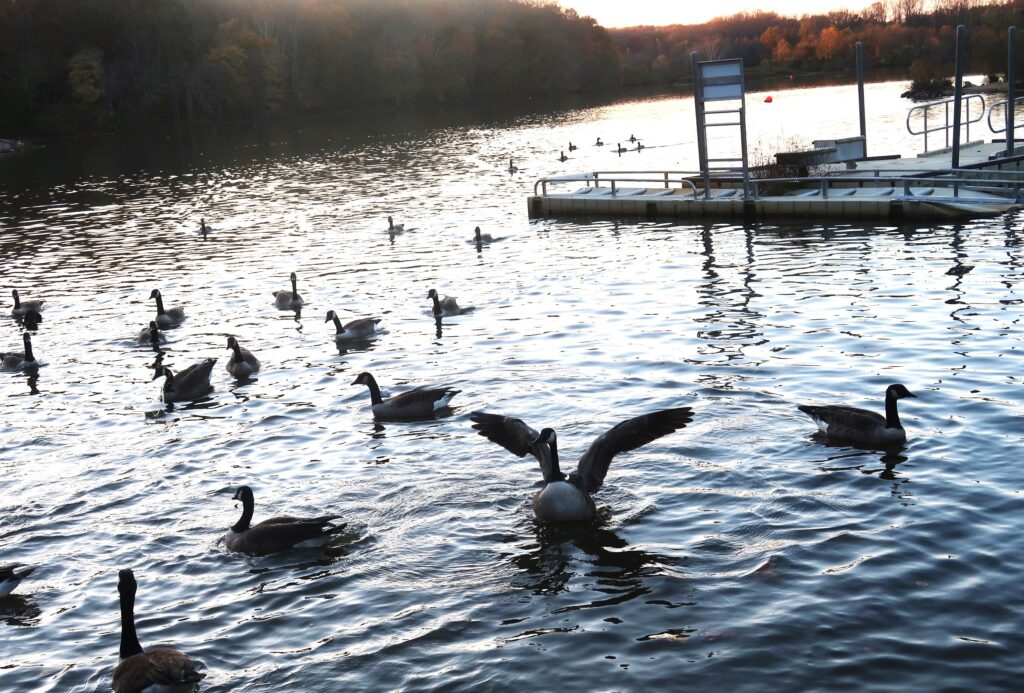The Lake Accotink Task Force is looking at the benefits of retaining the lake

The Task Force on the Future of Lake Accotink is looking at a broad array of issues – such as the impact on the environment, the habitat, recreation, and equity – as it develops a recommendation on how much of the lake should be saved.
The task force is scheduled to present its findings to the Board of Supervisors by the end of the year. The board created the task force in May after a recommendation by public works staff to stop dredging Lake Accotink met with widespread community opposition.
At the task force’s Nov. 6 meeting, there was some discussion about the need to gather more data, but chair Sharon Bulova expressed concerns about delays in getting the work done to stabilize the lake.
“I hope we can do some dredging so we can have a lake whether it is full size or smaller,” she said. “The longer we wait, the more difficult and expensive it will be.”
Related story: New playground opens at Lake Accotink
At the meeting, Craig Taylor, a hydraulics and river rehabilitation specialist with LimnoTech, gave a technical presentation on the amount of sediment coming into the lake and moving downstream and the regulatory hurdles and permits required if the lake is reduced in size.
While there is a lot of data on the sediment load, there are major gaps and the numbers keep changing in response to upstream development and weather.
The task force committee charged with looking at options other than full dredging is considering three alternatives for creating a smaller lake – 41, 33, and 21 acres – combined with wetlands, reported committee chair John Cook. Lake Accotink is currently 55 acres.
The bigger the lake, the greater the cost, Cook said. A larger amount of sediment would need to be dredged, and figuring out where to put it would be more challenging.
With a smaller lake, the spoils could be kept within Lake Accotink Park. A smaller lake along with wetlands or grasslands would maximize biodiversity.

“It’s really a question of which factors are more important,” Cook said. “We won’t have a perfect plan that everyone agrees with.” But waiting another five or 10 years while more studies are done would lead to a worse outcome.
Another committee is looking at the impacts of and issues with the staff recommendation not to dredge. Committee chair Sandy Collins said the staff based its decision on the sediment load and the cost of dredging but failed to consider other factors, including the value of recreation and the cost of not dredging.
Collins said the county is still required to do stream restoration whether the lake is dredged or not, and that could reduce the sediment load.
“We need a lot more data and a better understanding of the downstream impacts,” she said.
Related story: Dredging Lake Accotink is not financially or environmentally feasible
Allan Robertson, chair of the committee on the value of Lake Accotink to Lake Accotink Park and to the county, found fault with the survey done by the county to gauge the community’s perspectives on the lake.
For example, the survey found the most popular feature in the park is the trail, which led the staff to conclude that the trail will continue to be used whether there’s a lake or not.
But people like to walk on the trail because it’s next to the lake, Robertson said. That’s also true for the playground, carousel, and picnic pavilions. “The lake provides value to all of those amenities; we just don’t know how much.”
People come to the park to fish, kayak, view wildlife, feed the geese, and enjoy a sunset; all of those are important assets to the community – including lower-income families who rely on the lake to relieve the pressures of daily living. And that ties into the county’s One Fairfax policy to promote equity.
“We all recognize the benefits of having access to green space,” Robertson said. “Not enough has been said about the value of blue space.”


Would be nice to save the lake but – How many mullions did the BoS just start giving away under the guise of income distribution to certain people in certain zip codes with no accountability? – I certainly hope that all but one of the Board is tossed in this election – we cannot afford these progressives any more…Oh, don’t get me started on the Green New Fraud either…these progs think they can cool the planet…..
Well, there are some strategies for removing heat trapping gas from the atmosphere, including one as simple as planting and preserving forests. However, it is just as important to stop pumping heat-trapping gas into the atmosphere by reducing combustion of fossil fuels and capping methane leaks. Does that help?
On the point of “equity”, the County seems to forget that Lake Accotink is the ONLY park in the Fairfax County Park Authority system in which there is accessible access to the water without traversing unpaved, gravel, and or,rough surface terrain. Lake Accotink is completely accessible. Go,there any day and you can see people enjoying the benefits of water views from their cars or from the nearby benches or pavilions that are easily reachable in a wheelchair. Please don’t take that benefit away from the County residents who need that accommodation.
As usual, another article comes out that says the county is trying to reduce the lake to wetlands to save money, and doesn’t include these details:
– wetlands don’t just appear. They need to be constructed and maintained. It’s not magic. This is a completely man made lake. Left to it’s own devices it’ll degrade to a creek, and nothing else.
– The lake currently mitigates downstream silting. By removing that capacity to “save money”, the county simply shifts costs from the lake and dredging to an unknown number of projects further down in the watershed, which will cost significantly more.
– the upstream portion of the watershed is degrading exponentially faster, and the primary reason are major construction projects for highways, the hospital expansion, and new bike lanes and road widening. There’s videos shared by folks in the Save Lake Accotink group where you see essentially mudslides going directly into the watershed from these construction sites, with none of the proper mitigation efforts and absolutely zero consequences from the county. Completely ignoring the major cause of the problem, while at the same time ‘planning for stream restoration’, which is a complete waste of time if these construction issues keep happening
– the “out of control” costs are because the county initially studied a one-time dredge (which was last done in the 70s), and then later, forecasted the cost out over the next 50 years to do ‘mini dredging’. Of course the cost exploded, you just added a new variable, and when does the county bother to think ahead and forecast and plan expenses for the future, let alone 5 decades? Only when they’re trying to bump up their numbers
– Rodney Lusk, the chairman and PR golden boy of the BoS, skips all of the meetings, including the Zoom round table he could’ve done from his toilet. Most recently he missed the ribbon cutting at the playground. The BoS could not care less about the lake and they’d love for the problem to just go away. If it weren’t for the task force, no one would be even paying attention to this issue.
This problem is being caused by the County, with lack of code enforcement, playing word and number games with the budget, and doing a lot of hand waving to make it look like they’re doing something, when they’re really just running the clock down until the problem is so bad there is no dredge mitigation possible. And it’s hilarious that they claim to be so concerned with their parks and watersheds and environmentally focused when this project has them all in one, and all they have to do is dredge and enforce some upstream rules. But no, we’ll do a grocery bag tax to get some side money and then claim it’s improving the Chesapeake. But this waterway that feeds right into the watershed….na. Can’t be bothered. Vote for us!
Spot in, Bob!
You nailed it! The BoS and the county staff are the problem! Any developer building upstream and any developer who built upstream in the past 50 years should be funding a sediment processing plant on the Dom Power property — and a giant fine for Dom Power is probably in order as well.